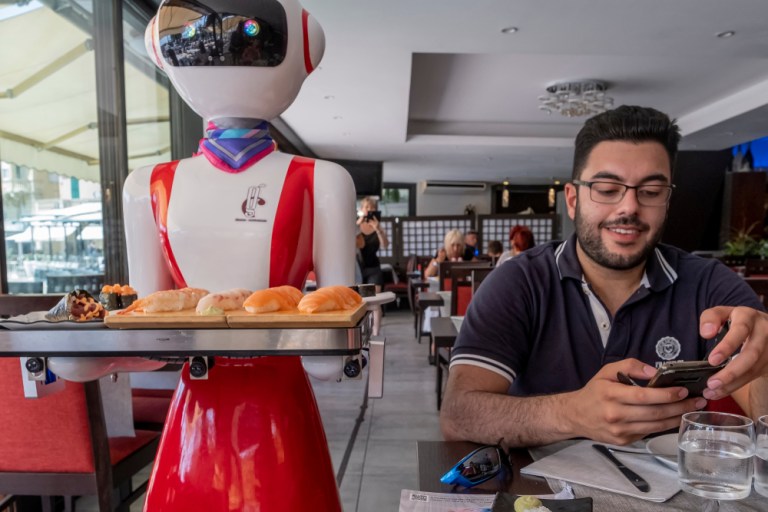Automation has touched and transformed many aspects of daily life. Dining and food preparation have primarily remained on the sidelines — until now.
Consumers may soon be in for a digitized dining experience, as a taste of the automation already redefining shipping and retail could reshape the restaurant and food delivery experience. As of today, few have directly experienced innovations such as food delivery by self-driving car or drone. Many are unaware of the innovations around the corner — or those already being implemented in the back of the house — but there are already some converts. As with all things new, a fusion of curiosity, excitement, hesitation and skepticism comes with the territory.
“Connected Dining: The Robot Will Take Your Order Now” is an independently produced PYMNTS report that explores consumer sentiment regarding food preparation and delivery automation. PYMNTS surveyed 1,971 United States consumers between June 13 and June 18 to gauge their opinions and explore what factors made them feel enthusiastic, curious or hesitant regarding their dining experience — particularly with automation of food preparation and delivery.
This is what we learned.
Key Findings
Consumers are interested in robotic or automated food preparation and delivery because they believe these restaurant features will increase speed and value.
Speed seems to be a significant motivator for hungry consumers. PYMNTS’ latest data found that 46% of consumers interested in automated food preparation expect that automation would lead to faster preparation of their meal. Similarly, 48% of those interested in automated food delivery expected automated delivery to be faster.
Among consumers already interested in virtual kitchens — settings that do not have a physical location but rather prepare phone or online orders and serve customers via delivery or pickup — 77% thought that automation would result in faster preparation of dishes, making the process easier and more convenient. More than 30% opined that they were interested in virtual kitchens because they could personalize their dishes — perhaps because they would feel less comfortable asking a human to accommodate them.
Cost is also a supplementary factor. Among those interested in automated food delivery, 37% reported they were interested because they expected they would not have to tip for delivery, and 33% anticipated that automated food delivery would lead to decreased delivery costs.
Tech-driven restaurant experiences appeal most to younger, higher-earning or male consumers.
Habits can be hard to break. Baby boomers and seniors are particularly hesitant about tech-driven, automated dining experiences, perhaps because the human element — a chef whose food they enjoy, the server they’ve known for years, or the host that can arrange for a nice table — largely influences their dining habits and experiences.
Unsurprisingly, roughly 7% of baby boomers and seniors are interested in robots or automation for food prep or delivery. Generations who have grown up with more technology in their daily lives are more interested in trying out automated cuisine. Forty-two percent of bridge millennials, for example, are very or extremely interested in automated food prep and delivery — as are more than one-third of millennials and members of Generation Z.
Interest in tech-driven dining experiences also varies by income and gender. Those earning more than $100,000 are the most likely to be very or extremely interested in trying out the innovative methods making their way into dining, with 28% expressing this high interest in robots and automation for food prep.
More men than women have already visited a restaurant that uses robotics for cooking; 21% of men have done so, more than twice the 10% of women. While 33% of men were very or extremely interested in visiting a restaurant that uses robotics for food preparation, just 17% of women were similarly interested.
When asked if they were interested in trying a restaurant that uses robotics, 83% of women raised a skeptical eyebrow, but 33% of men were up for it.
Consumers are largely unaware or skeptical of automated food preparation or delivery despite growing interest.
Automation in dining is a relatively new phenomenon, at least compared to other sectors such as banking and eCommerce. When consumers do not know or are not familiar with something, they tend to be hesitant, curious or perhaps a mix of both. Surveyed consumers as a whole are mildly, if at all, curious about the automation of food services. Sixty-nine percent are not at all or slightly interested in automated food delivery, and 65% feel the same about automated food prep.
Although many interested in automated food prep thought robots would deliver higher quality food, those who are uninterested disagree. Eighty-three percent said they believe food prepared with automated systems or robots would be lower quality and less personalized than food prepared with the personal touch of a chef or sous chef. Similarly, 74% were concerned that automation would mean that human workers would lose their livelihoods.
Consumers are also worried about how robotics will impact the delivery ecosystem. Per PYMNTS data, 73% of consumers uninterested in automated food delivery are concerned about job displacement or lack of human interaction. Those consumers also do not necessarily think that automation will reduce costs, as 1 in 3 expect higher delivery costs when a drone, robot or self-driving car delivers the food. After all, technology won’t come for free.
Conclusion
Technological innovations in dining involving robotics and automation are not relatively well known by consumers, so they often approach the notion with a mix of curiosity and skepticism. Nonetheless, automating the food preparation and delivery process has upsides.
While a delivery driver may get stuck in traffic, robots may roll down a sidewalk, sidestepping traffic, or drones may fly above it. A robot or a drone does not need breaks or to take time off — aside from occasional charging or maintenance — to attend to life matters, whereas people do. A robot could ingest all specifications in an order without any deviations, promoting food personalization as machine chefs skip the cilantro and put the dressing on the side. Additionally, employers do not need to pay robots, and machines do not expect tips, although humans would.
On the flip side, installing technology takes time and effort, and interested consumers’ drivers of interest — speed and convenience — can be hard to measure. Although 30% of consumers interested in virtual kitchens are enthused to avoid interactions with people, more than two-thirds of consumers who lack interest in these innovations worry about the displacement of the human element — and those jobs disappearing.
Even the most excited individuals — consumers who are most likely to be younger, higher earning or male — acknowledge that manufacturers must still refine delivery drones equipped with GPS to figure out, for example, how to knock on apartment 345 on the third floor of a building with a locked entrance. Carrying a heavy order across multiple miles may also pose a challenge.
Restaurants experimenting with these technologies that can overcome reticent customers’ concerns may find that the speed and quality advantages prove critical, especially as the economy continues highlighting the values of speed and cost efficiency. In time, consumers may become ready to let Chef Robot take, make and deliver food orders — and maybe even leave a little fortune cookie or a bite of chocolate along with the check to sweeten the deal.
Methodology
“Connected Dining: The Robot Will Take Your Order Now,” produced independently by PYMNTS, examines and analyzes consumer sentiments around automating food preparation and delivery. We surveyed 1,971 U.S. consumers between June 13 and June 18 about their experiences and perceptions. The sample was balanced to match the U.S. adult population in a set of key demographic variables. Our respondents’ average age was 47, 56.2% were female, and 44% earned more than $100,000 annually.
“Connected Dining: The Robot Will Take Your Order Now” is the most recent installment of PYMNTS’ Connected Dining series. For more, read the previous edition, “Connected Dining: Word of Mouth in the Digital Age.”




